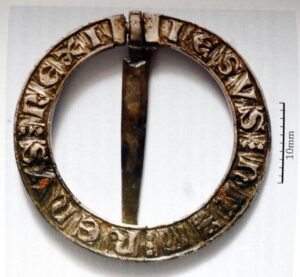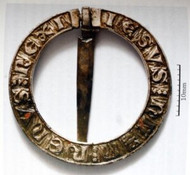Boyerstown Ring Brooch
Posted by Charles MacGregor on May 19th 2019
Originally published July 2013. Written for The Celtic Croft by Charles MacGregor of MacGregor Historic Games.
The Boyerstown Ring Brooch

Just a little look at an artifact and the possible symbolism.
The Boyerstown Ring Brooch was found during an excavation of a 12th to 14th century site that was discovered during the construction of the M3 Motorway in Ireland and not far from Navan, Ireland. I learned an interesting tidbit while reading about the excavation. An article I found said that starting in 2001 Ireland changed their road construction strategy in regard to possible archeological sites along proposed routes. Rather than simply watch for artifacts or evidence of structures as construction proceeds, they have been actively surveying the route ahead attempting to seek out previously unknown sites. This allows provides researchers more time to excavate before the the construction reaches that point, and can minimize the construction delays that occur when they just stumble on a potential site.
The "Boyerstown 1" site consisted of two structures built of dry stone walls that had at some time been demolished. A systematic metal detection survey uncovered 420 metal finds including nails, buttons, buckles and coins. After the topsoil was sieved the artifact count rose to 11,000 items including more metal items, stone artifacts, and large numbers of pottery fragments. The quality of some of the metal work and jewelry found suggest the owners were relatively wealthy, and possibly it was the holding of a free-tenant.
Of course the brooch pictured above is what caught my interest. It is about 3 centimeters in diameter. On the front is a Latin inscription "IESVS NAZARENVS REX I", a shortened version of "Jesus of Nazareth, King of the Jews". Which is, of course, the sign said to have been mockingly placed above the head of Jesus at his crucifixion. This would not have been just a reflection of religious devotion. During the Middle Ages the "Titulus Crucis" (Latin for the "Title of the Cross) was believed to have worked like an amulet. It was said to provide protection against violent death, or sudden harm, and it or the initials symbolizing the Titulus was common on such ring broaches or and other jewelry.
On the reverse side there are four creatures. Two are stylized birds which are believed to be pelicans. The pelican is a known metaphor, or symbol for Jesus. Pelicans can sometimes suffer from a disease which causes a red mar on their breasts. This is is believed to have given rise to the myth that when pelicans could not find fish to feed their young, they would tear open their breast and feed their own blood to the nestlings. Portrayals of this sacrifice, known as a "pelican in piety," represented the sacrifice of Jesus. There is apparently some traces of red enamel in the recesses of the broach which could also have symbolized the blood of the pelican and Christ.
The other two creatures are a little more puzzling. They are also bird-like, but on close inspection they have human shaped heads. Much like mermaids, creatures with female human heads and the bodies of birds were a form of siren that comes to us from classical mythology. With their ability to lure travelers to their deaths, the portrayal of a siren along with otherwise pious inscriptions suggests a warning against the dangers of temptation. Thus, perhaps we have here a bit of jewelry that was intended both as a protective amulet, as well as reminder to the wearer to protect themselves from sin.

